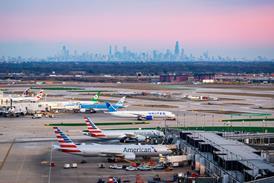The fatal Bell-Boeing MV-22 crash in Hawaii on 17 May could prompt the US Marine Corps to adopt an improved engine filtration system being developed for the CV-22 operated by the air force.
Two marines died and 20 others were injured when the MV-22 went into freefall during a restricted visual landing (RVL) at Bellows Air Force Station.
A Judge Advocate General Manual (JAGMAN) investigation released internally this week attributes the training accident to “repeated, sustained flight time in brownout conditions” while attempting to land, causing compressor stall on the left Rolls-Royce AE1107C turboshaft engine. Sand and dust ingestion from the rotor wash caused significant material buildup on the turbine blades.
According to a statement by Marine Forces Pacific, investigators blame pilot performance and underestimation of the amount of debris on the landing zone. The pilot didn’t violate any regulations or flight standards and the aircrew performed all emergency procedures as instructed.
Investigators made several recommendations, including improving the Osprey’s engine air filtration system, and the recommended exposure time for RVLs has since been reduced from 60s to 35s or less – according to a marine corps spokeswoman.
Other recommendations involve giving the pilot more data by displaying performance and stall margins on the cockpit’s multifunctional display, and an alert for the pilot when engine power drops below 95%.
The V-22 joint programme office is already developing an “engine inlet barrier filter” under the $70 million Improved Inlet Solution project awarded to Bell-Boeing in July 2014, but so far only the air force has committed to it for the special forces CV-22 variant. The upgrade adds “oil-wetted, cotton-media filters” and a bypass door to the engine inlet.
According to V-22 programme chief USMC Col Dan Robinson, wind tunnel testing is planned for December 2016 and should wrap up in 2017. “At that time we’ll look at production of it,” he said at the recent Dubai air ahow, adding that the marines will assess the solution once developed.
Source: FlightGlobal.com






















